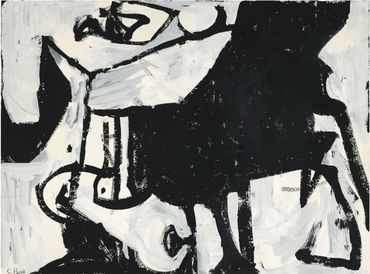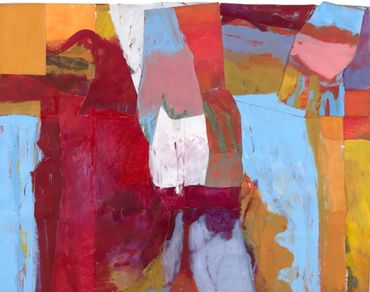
b. Concord, MA, 1918 - d. East Hampton, NY, 2010
Charlotte Park
Charlotte Park was born in Concord, Massachusetts and graduated from the Yale School of Art in 1939. Her early works were muscular abstractions, often in a monochrome palette. During WWll, Park worked for the Office of Strategic Services in Washington, D.C. and it was there that she met James Brooks. Together, the couple moved to New York City in 1945 where Park studied privately with the Australian artist Wallace Harrison. Her first solo exhibition was in 1957 at Tanager Gallery.
Invigorated by the rise of Abstract Expressionism, the couple became close friends with many of the movement's pioneers, including Lee Krasner and Jackson Pollock, Franz Kline, and Willem and Elaine de Kooning. In 1948, like so many artists of the New York School, the couple found a home and studio on Long Island's east end. Living in the bucolic landscape would have a profound effect on Park's work.
By the mid-1950s, Park began to embrace color and develop a style in which lyricism was conjoined with dramatic form and bold compositional elements. She explored collage, creating complex, layered works. Later, her compositions became more minimal, owed in part to her interest in Neo-plasticism and the art of Piet Mondrian. She became a naturalist, maintaining journals that contained assiduous notes on birds, plant species, and aspects of the natural world.
In 2010, the New York Times art critic, Roberta Smith, called Park "a natural painter and a gifted colorist."
Park lived on Neck Path in Springs until her death in 2010.

Charlotte Park seated in the living room of the house in Montauk.
Selected Works 1950-1979
.c1960.gouache%20.jpg/:/cr=t:0.05%25,l:0%25,w:100%25,h:99.9%25/rs=w:370,cg:true)





CHARLOTTE PARK: THE LIFE OF FORMS IN COLOR
PARRISH ART MUSEUM
October 27, 2024–March 2, 2025
Guest Curated by Dr. Klaus Ottmann
Charlotte Park: The Life of Forms in Color is a survey comprising more than 70 paintings and works on paper, drawn exclusively from the 2017 gift of works to the Parrish by the James and Charlotte Brooks Foundation. Overshadowed by the attention given to the work of her husband, James Brooks, Park kept a fairly low profile over the course of her career while painting some of the strongest and most brilliantly colored canvases of her time. Color and form, often related to the living environment surrounding the studio she shared with her husband, were strong and constant forces in her work.
image: installation view, photo by Gary Mamay / Parrish Art Museum
ARTS & ANTIQUES
Charlotte Park: The Quiet Abstractionist
by John Dorfman
Charlotte Park, a master of line and color, is at last being given her rightful place in the galaxy of Abstract Expressionists.
By the time she finally began to get the recognition she deserved, the painter Charlotte Park was already past 90 and suffering from Alzheimer’s disease. As a result, it’s likely that the glowing review New York Times art critic Roberta Smith gave her 2010 exhibition at Spanierman Modern did not impinge much on her awareness. On the other hand, it’s also likely that even if it had, or if the recognition had come earlier, Park would not have been overly impressed.
image: Charlotte Park, Untitled, circa 1963, oil on canvas, 127 x 127 cm.
© James Brooks and Charlotte Park Foundation.
Courtesy of Berry Campbell Gallery.
BERRY | CAMPBELL GALLERY
Charlotte Park: Works on Paper from the 1950s - March 17 - April 23, 2022
This website uses cookies.
We use cookies to analyze website traffic and optimize your website experience. By accepting our use of cookies, your data will be aggregated with all other user data.

TAKE ACTION
HELP SAVE THIS PLACE
Send a letter to the East Hampton Town Board expressing your support for the restoration of the Brooks-Park Home & Studios.
Use our template and the email addresses provided on the Welcome page, or click on the button below to email our Town Board liaison, councilman Tom Flight directly.
Donate now and your gift will be doubled up to $10,000 thanks to the RDLGF Challenge Match Grant from the Gardiner Foundation. Make a contribution of any amount securely online.
THANK YOU
